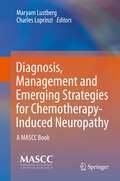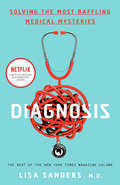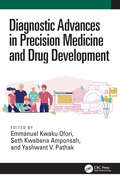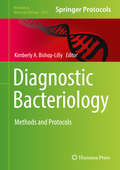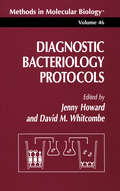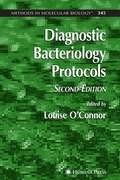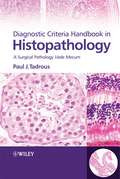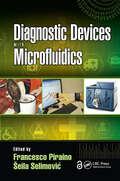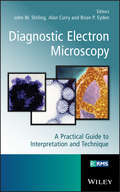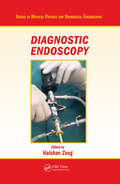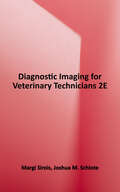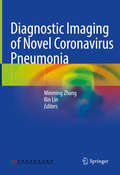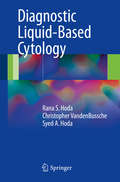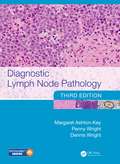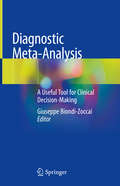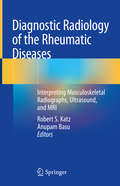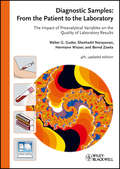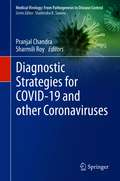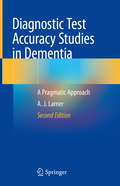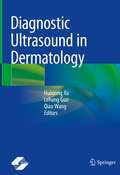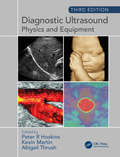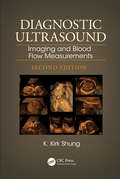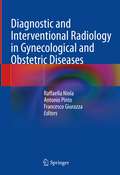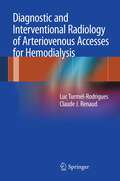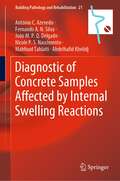- Table View
- List View
Diagnosis, Management and Emerging Strategies for Chemotherapy-Induced Neuropathy: A MASCC Book
by Maryam Lustberg Charles LoprinziThis book comprehensively examines chemotherapy-induced peripheral neuropathy (CIPN), a common dose-limiting condition that negatively affects both the quality of life of cancer patients and disease outcomes. CIPN remains a challenging area for both clinical care and research, as there are multiple unresolved issues. Written by leading international experts, the book discusses the natural history of CIPN, the latest predictors of toxicity, instruments for evaluating symptoms, and prevention/therapeutic strategies, as well as patients’ experiences of this common clinical syndrome. Lastly it highlights avenues for future research to enhance our understanding of CIPN. Providing essential information on the management of CIPN and the latest research in the field, this book is a valuable resource for researchers and healthcare providers working with patients with various malignant diseases.
Diagnosis: Solving the Most Baffling Medical Mysteries
by Lisa SandersA collection of more than fifty hard-to-crack medical quandaries, featuring the best of The New York Times Magazine's popular Diagnosis column—now a Netflix original series&“Lisa Sanders is a paragon of the modern medical detective storyteller.&”—Atul Gawande, author of Being MortalAs a Yale School of Medicine physician, the New York Times bestselling author of Every Patient Tells a Story, and an inspiration and adviser for the hit Fox TV drama House, M.D., Lisa Sanders has seen it all. And yet she is often confounded by the cases she describes in her column: unexpected collections of symptoms that she and other physicians struggle to diagnose. A twenty-eight-year-old man, vacationing in the Bahamas for his birthday, tries some barracuda for dinner. Hours later, he collapses on the dance floor with crippling stomach pains. A middle-aged woman returns to her doctor, after visiting two days earlier with a mild rash on the back of her hands. Now the rash has turned purple and has spread across her entire body in whiplike streaks. A young elephant trainer in a traveling circus, once head-butted by a rogue zebra, is suddenly beset with splitting headaches, as if someone were &“slamming a door inside his head.&”In each of these cases, the path to diagnosis—and treatment—is winding, sometimes frustratingly unclear. Dr. Sanders shows how making the right diagnosis requires expertise, painstaking procedure, and sometimes a little luck. Intricate, gripping, and full of twists and turns, Diagnosis puts readers in the doctor&’s place. It lets them see what doctors see, feel the uncertainty they feel—and experience the thrill when the puzzle is finally solved.
Diagnostic Advances in Precision Medicine and Drug Development
by Emmanuel Kwaku Ofori, Seth Kwabena Amponsah, and Yashwant V. PathakTo arrive at the most appropriate decision regarding patient management, an essential step for medical practitioners is to determine a correct and accurate diagnosis of the patient’s condition. In recent years there have been significant technological efforts in chemistry, biochemistry, laboratory science, and biotechnology toward improving disease diagnosis and management in patients. Further, drug developers have utilized some of these novel diagnostic methods during preclinical and clinical trials that have led to creating efficiencies in their development processes. This book provides an overview of diagnostic procedures that aid in precision medicine and the drug development process. Presents innovative methodologies for diagnostic testing that will be beneficial to biomedical science researchers and health professionals Discusses recent significant technological advancement toward improving disease diagnosis Describes recent developments in spectroscopic and chromatographic methods that will be of interest to pharma companies and scientists in chemistry, biochemistry and pharmacology Gives an overview of the integration of artificial intelligence in digital health that will be beneficial to biotechnologists, bioengineers, health professionals and people in regulatory agencies Is suitable globally for graduate and postgraduate students studying laboratory medicine
Diagnostic Bacteriology
by Kimberly A. Bishop-LillyThis volume provides a comprehensive collection of protocols on molecular diagnostics of bacteria that will suit the needs of molecular biologists, clinical laboratorians, and physician scientists alike. Chapters detail common bacterial pathogens, protocols that can be applied to diverse or even unknown pathogens, digital PCR, next generation sequencing, and bioinformatic analyses. Written in the highly successful Methods in Molecular Biology series format, chapters include introductions to their respective topics, lists of the necessary materials and reagents, step-by-step, readily reproducible laboratory protocols, and tips on troubleshooting and avoiding known pitfalls. Authoritative and practical, Diagnostic Bacteriology: Methods and Protocols delivers a wide range of assay types all on the cutting edge of diagnostic bacteriology.
Diagnostic Bacteriology Protocols
by Jenny Howard David M. WhitcombeDiagnostic Bacteriology Protocols presents a broad range of currently used techniques for detecting, identifying, and differentiating bacterial cell components, including structured proteins, nucleic acids, enzyme activities, lipopolysaccharides, and metabolites. It describes each technique in simple easy-to-follow steps that guarantee reproducible results for novices and senior researchers alike. Troubleshooting tips, alternative ways of performing procedures, and informative explanations about why certain steps are necessary-aids not usually found in standard journal recipes help even highly skilled researchers to obtain the results they want.
Diagnostic Bacteriology Protocols
by Louise O’connorThis fully updated edition includes the novel identification, detection, and typing technologies that are transforming the field of diagnostic testing. The authors, working at the forefront of diagnostic test development, highlight these new technologies and describe current and future molecular diagnostic tests and related nucleic acid extraction methods. The protocols range from advanced molecular detection, quantification, and typing systems, to protocols for diagnostic protein identification, serological testing, and cell culture-based assays. The emphasis is on nucleic acid-based diagnostics and alternative biochemically- and immunologically-based formats that can provide significant potential for multiparameter testing and automation.
Diagnostic Criteria Handbook in Histopathology
by Paul J. TadrousThis handbook is designed to help jobbing histopathologists jog their memory and get through more workload in any working day. Rapid access is facilitated by a bullet-point, tabular and diagrammatic style, as well as by handy anatomical diagrams, guidance on the 'Cut-Up' with emphasis on core 'datasets' and by a special index for frozen section advice, grading systems and scoring systems. The book provides, where useful, differential diagnosis lists and presents diagnostically helpful molecular and immunohistochemical findings. Information is kept up-to-date on a dedicated website www.pathbook.com. The Diagnostic Criteria Handbook in Histopathology is not designed to be an "exam cram" and neither will it serve as a basic text for beginners. Trainees, however, will still benefit from the sheer breadth of topics covered in this one small volume: from lab management and lab methods, to autopsy practice, cytology and all sub-specialties in surgical pathology. A chapter on exam technique and mnemonics makes the book also an essential companion for those revising for professional exams. So why clutter your precious desk space with multiple sets of heavy two-volume reference works?Give this handy Vade Mecum a place next to your microscope and see how much time you could save!
Diagnostic Devices with Microfluidics (Devices, Circuits, and Systems)
by Francesco Piraino Šeila SelimovićThis book provides a current view of the research and commercial landscape of diagnostics devices, particularly those that utilize microscale technologies, intended for both patient and laboratory use. Common diagnostic devices that are based on microfluidic principles include glucose sensors for diabetic patients and over-the-counter pregnancy tests. Other diagnostic devices are being developed to quickly test a patient for bacterial and viral infections, and other diseases. The chapters, written by experts from around the world, discuss how to fabricate, apply, and market microfluidic diagnostic chips – for lab and at-home use. Most importantly, the book also contains a discussion of topics relevant to the private sector, including patient-focused, market-oriented development of diagnostics devices. <P><P>Chapter 9 of this book is freely available as a downloadable Open Access PDF under a CC-BY 3.0 license. https://s3-us-west-2.amazonaws.com/tandfbis/rt-files/docs/Open+Access+Chapters/9781498772938_oachapter9.pdf
Diagnostic Electron Microscopy
by John Stirling Brian Eyden Alan CurryDiagnostic Electron Microscopy: A Practical Guide to Interpretation and Technique summarises the current interpretational applications of TEM in diagnostic pathology. This concise and accessible volume provides a working guide to the main, or most useful, applications of the technique including practical topics of concern to laboratory scientists, brief guides to traditional tissue and microbiological preparation techniques, microwave processing, digital imaging and measurement uncertainty.The text features both a screening and interpretational guide for TEM diagnostic applications and current TEM diagnostic tissue preparation methods pertinent to all clinical electron microscope units worldwide. Containing high-quality representative images, this up-to-date text includes detailed information on the most important diagnostic applications of transmission electron microscopy as well as instructions for specific tissues and current basic preparative techniques.The book is relevant to trainee pathologists and practising pathologists who are expected to understand and evaluate/screen tissues by TEM. In addition, technical and scientific staff involved in tissue preparation and diagnostic tissue evaluation/screening by TEM will find this text useful.
Diagnostic Endoscopy (Series in Medical Physics and Biomedical Engineering)
by Haishan ZengCombining a professional development course on diagnostic endoscopy from SPIE (the international society advancing light-based research) and the authors' graduate course on biomedical optics, this work is written for researchers in medical optics and biomedical engineering as well as graduate medical optics students. It uses extensive examples/case
Diagnostic Imaging for Veterinary Technicians, 2E
by Margi Sirois Joshua M. SchloteDiagnostic Imaging for Veterinary Technicians is a comprehensive diagnostic imaging textbook, which includes detailed positioning information for radiographic studies in the small animal clinic. The text showcases a systematic approach to the positioning of feline, canine, equine, and exotic animal patients for routine and special radiographic procedures, including dentistry procedures.
Diagnostic Imaging of Novel Coronavirus Pneumonia
by Minming Zhang Bin LinThis book presents radiological findings in patients with 2019 Novel Coronavirus Pneumonia (COVID-19). It starts with a general review of COVID-19 Pneumonia discovery, including etiology characteristics, transmission routes and pathogenic mechanisms. In the following chapters, details in clinical classification, imaging manifestations in different groups, and imaging features of family aggregated coronavirus pneumonia are introduced. In addition, key points in differential diagnosis of COVID-19 Pneumonia are summarized in the last chapter. The book provides a valuable reference source for radiologists and doctors working in the area of COVID-19 Pneumonia.
Diagnostic Liquid-Based Cytology
by Rana S. Hoda Christopher Vandenbussche Syed A. HodaLiquid-based cytology preparations are currently the standard of care for gynecological cytology, and are being increasingly used for non-gynecological cytology. Diagnostic Liquid-Based Cytology serves as a handy guide to diagnostic cytopathology on liquid-based preparations. The authors, renowned experts in the field, provide clear, concise, and practical diagnostic guidance. This handbook equips you to achieve accurate diagnosis of most commonly and uncommonly encountered diseases in exfoliative and aspirated tissue samples from various sites. The key cytopathological features of various diseases are described. The book is lavishly illustrated with dozens of color images that depict the full range of common and rare conditions. Diagnostic Liquid-Based Cytology offers highly practical guidance and information needed to solve common diagnostic challenges in liquid-based cytology preparations. Appropriate histopathological correlations and a consideration of the possible differential diagnosis accompany the cytological findings. The book is an excellent resource not only for practicing pathologists as well as for pathologists-in-training, and will be the perfect practical resource for daily reference in the cytopathology laboratory.
Diagnostic Lymph Node Pathology
by Margaret Ashton-Key Penny Wright Dennis WrightDiagnostic Lymph Node Pathology presents a logical and systematic approach to lymph node biopsies and guides general pathologists and haematopathologists alike through the maze of differential diagnoses, enabling them to reach an accurate diagnosis. The book is presented in an easy-to-read format and contains boxes for quick reference detailing the clinical, morphological, immunohistochemical, and genetic features of each entity. Thoroughly revised, the third edition also includes more than 300 high-quality histological colour photographs along with updated references. This edition covers both classical and less well-known features of individual disease processes. It is a valuable guide for both professionals and trainees.
Diagnostic Meta-Analysis: A Useful Tool for Clinical Decision-Making
by Giuseppe Biondi-ZoccaiThis book is the first exclusively devoted to the systematic synthesis of diagnostic test accuracy studies. It builds upon the major recent developments in reporting standards, search methods, and, in particular, statistical tools specifically devoted to diagnostic studies. In addition, it borrows extensively from the latest advances in systematic reviews and meta-analyses of intervention studies. After a section dedicated to methods for designing reviews, synthesizing evidence and appraising inconsistency in research, the application of these approaches is demonstrated in the context of case studies from various clinical disciplines. Diagnosis is central in medical decision-making, and in many other fields of human endeavor, such as education and psychology. The plurality of sources of evidence on diagnostic test accuracy poses a huge challenge for practitioners and researchers, as do the multiple dimensions of evidence validity, which include sensitivity, specificity, predictive values, and likelihood ratios. This book offers an invaluable resource for anyone aiming to improve decision-making processes in diagnosis, classification or risk prognostication, from epidemiologists to biostatisticians, radiologists, laboratory physicians and graduate students, as any physician interested in refining his methodological skills in clinical diagnosis.
Diagnostic Radiology of the Rheumatic Diseases: Interpreting Musculoskeletal Radiographs, Ultrasound, and MRI
by Anupam Basu Robert S. KatzThis book provides an introduction to the role of medical imaging in the diagnosis and management of rheumatologic diseases. It reviews basic radiographic findings of common and rare arthropathies while offering a focused and practical discussion of advanced imaging modalities such as CT, ultrasonography, and MRI. The book begins with a discussion on soft tissue changes, bone and bone density, articular surface changes, and bone alignment. Following this is an examination of the use of advanced imaging modalities including CT, ultrasound, and MRI as well as different disease categories such as inflammatory arthritis, degenerative arthritis, infectious arthritis, and crystalline arthropathy. Subsequent chapters include exercises and case examples for imaging hands and wrists, knees, hips, foot and ankle, shoulder, and the spine. Diagnostic Radiology of Rheumatic Diseases is an essential and practical resource for senior medical students, residents, fellows, and physicians in rheumatology, imaging and radiology, immunology, and internal medicine.
Diagnostic Samples: From the Patient to the Laboratory
by Walter G. Guder Sheshadri Narayanan Hermann Wisser Bernd ZawtaThis fourth, updated edition contains the latest developments in preanalytical knowledge. An international team of authors summarizes the information on biological influences, analytical interferences and on the variables affecting the collection, transport and storage, as well as preparation of samples. In so doing, they cover age, gender, race, pregnancy, diet, exercise and altitude, plus the effects of stimulants and drugs. National and international standards are described for sampling procedures, transport, sample identification and all safety aspects, while quality assurance procedures are shown for total laboratory management. In addition, this practical book is rounded off by a glossary explaining all terms being used. This book is a must-have for everyone involved in patient care and using or performing laboratory tests.
Diagnostic Strategies for COVID-19 and other Coronaviruses (Medical Virology: From Pathogenesis to Disease Control)
by Pranjal Chandra Sharmili RoyThis book provides fundamental information on various techniques for the detection of SARS-CoV-2 including reverse transcriptase (RT) PCR, loop-mediated isothermal amplification, immunodiagnostic tests, and CRISPR-Cas. It reviews various testing kits and detection methodologies that are currently being used for the detection of SARS-CoV-2 and examines strategies for the post-treatment detection and monitoring of SARS-CoV-2. Further, it assesses the diagnostic potential of several SARS-CoV-2 proteins; and analyzes their structural determinants and immunogenicity.In turn, the book evaluates the potential of CRISPR-Cas 12-based assays for the detection of SARS-CoV-2 using RNA extracted from patients. Lastly, it discusses the use of miniaturized biosensors for the detection of other types of coronavirus.
Diagnostic Test Accuracy Studies in Dementia: A Pragmatic Approach
by A. J. LarnerThe new and updated edition of this book explains the key steps in planning and executing diagnostic test accuracy studies in dementia, serving as an introduction to the topic with clear explanations of difficulties and pitfalls. It has been fully revised in light of developments over the past 5 years and includes STARD publications which have appeared since the first edition as well as the use of biomarkers of cognitive disorders as increasingly enshrined in diagnostic criteria. The book covers the presentation of study results in terms of measures of discrimination, taking examples from studies in dementia looking at various diagnostic methods including cognitive instruments, neuroimaging, and biochemical studies. The book continues to reflect the author’s own experience in diagnostic test accuracy studies, particularly in the sphere of cognitive screening instruments..Diagnostic Test Accuracy Studies in Dementia encourages clinicians to adopt a pragmatic approach to diagnostic test accuracy studies rooted in day-to-day clinical practice.
Diagnostic Ultrasound in Dermatology
by Qiao Wang Huixiong Xu Lehang GuoThis book offers readers details in application of high-frequency ultrasound in dermatology, a new method playing increasingly important roles in diagnosis of skin diseases. At first, chapters introduce anatomy and ultrasound features of normal skin. Then terminology, image quality, and artifact of dermatologic ultrasound are presented. After that, ultrasound features of benign and malignant skin tumors, inflammation, autoimmune disease, and traumas are described with diagnostic tips for specific disease. It will be a valuable reference book not only for dermatologist and radiologist, but also for plastic surgeon and cosmetologist.
Diagnostic Ultrasound, Third Edition: Physics and Equipment
by Peter R Hoskins, Kevin Martin and Abigail ThrushThis popular text provides a comprehensive, yet accessible, introduction to the physics and technology of medical ultrasound, with high quality ultrasound images and diagrams throughout. Covering all aspects of the field at a level that meetings the requirements of accredited sonography courses, it is ideal for both trainee and qualified healthcare professionals practising ultrasound in a clinical setting. Building on the content of previous editions, this third edition provides the latest guidance relating to ultrasound technology, quality assurance and safety and discusses the latest techniques.
Diagnostic Ultrasound: Imaging and Blood Flow Measurements, Second Edition
by K. Kirk ShungOffers an Extensive Discussion on High Frequency UltrasoundBased on a course taught and developed by a foremost expert in diagnostic ultrasound technology, Diagnostic Ultrasound: Imaging and Blood Flow Measurements, Second Edition covers cutting-edge developments, along with the fundamental physics, instrumentation, system architecture, clinical ap
Diagnostic and Interventional Radiology in Gynecological and Obstetric Diseases
by Antonio Pinto Raffaella Niola Francesco GiurazzaThis book focuses on the role of diagnostic and interventional radiology in obstetrical and gynecological diseases. It provides relevant information on each topic, considering both diagnostic and interventional radiology, which now belong to the same professional unit. Each chapter begins with a brief introduction to the most relevant clinical aspects of the pathology. Diagnostic examinations are also discussed, with a focus on the radiological studies (US/CT/MR) functional to subsequent procedures. This is followed by an interventional section, which clarifies the indications, contraindications, techniques (including choice of materials) and follow-up. Lastly, clinical cases are provided, together with multiple-choice review questions. Given its scope, the book will appeal to radiologists, gynecologists and obstetricians, as well as to residents in these specialties.
Diagnostic and Interventional Radiology of Arteriovenous Accesses for Hemodialysis
by Claude J. Renaud Luc Turmel-RodriguesThis is the first textbook entirely dedicated to the endovascular treatment of complications related to arteriovenous accesses for hemodialysis (native fistulas and prosthetic grafts). The book addresses the anatomy of upper limb arteries and veins as well as the clinical presentation of patients and the way to perform and read a fistulogram. Many details and illustrations are provided, clarifying the subtleties in catheterization and the dilation of stenoses. From a strategic point of view, it is explained for the first time that many stenoses must either be ignored or deliberately underdilated. A wealth of images helps to understand the different stages of access recovery from thrombosis. As the number of incident dialysis patients is increasing by 5% every year, this is a field of growing interest. In testament to this there are several annual or bi-annual meetings held by numerous national and international societies (vascularaccesssociety.com, sfav.org, vasamd.org, dialysiscontroversies.org, asdin.org).
Diagnostic of Concrete Samples Affected by Internal Swelling Reactions (Building Pathology and Rehabilitation #21)
by António C. Azevedo Fernando A.N. Silva João M.P.Q. Delgado Nicole P.S. Souza Mahfoud Tahlaiti Abdelhafid KhelidjThis book offers a complete diagnosis of concrete samples collected from a pile cap block of residential buildings affected by internal swelling reactions. Covering an extensive laboratory campaign to evaluate the transport properties of concrete samples, as well as their physical and chemical composition using advanced techniques to analyse cores extracted from real buildings that have concrete elements affected by internal swelling reactions (ISR). It features several rehabilitation procedures, pile caps repair and rehabilitation design, executed using strengthening procedures to provide the complete restoration of the structural integrity of the element deteriorated. These rehabilitation procedures proved to be a good solution to retrofit pile cap deteriorated by expansions due to internal swelling reactions of concrete. The book also offers a systematic review of the current state of knowledge and it is a valuable resource for scientists, students, and practitioners in various scientific and engineering disciplines, namely, civil and materials engineering, as well as and other interested parties.
